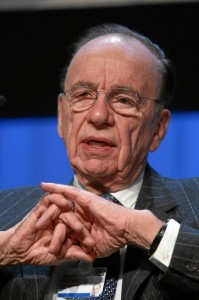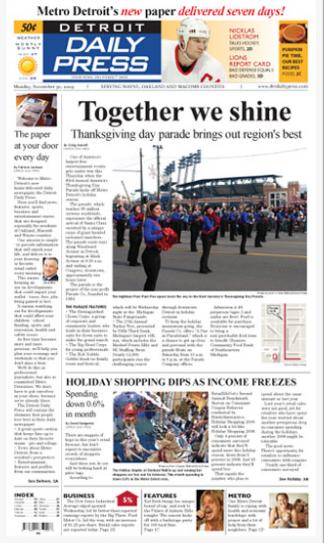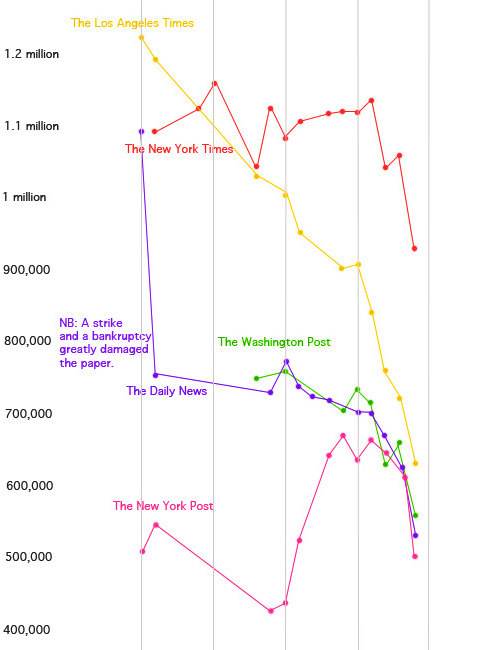 In one of the final feature stories in Editor & Publisher, which is closing after 125 years, Jennifer Sabba has an interesting dissection of the circulation experiment at the Dallas Morning News. That paper was one of the first to dig into the economics of circulation pricing in order to better understand elasticity. Newspapers have traditionally derived only about 20% of their revenue from circulation, but the wholesale collapse of categories like classified advertising has forced them to get creative. The Morning News is one of several newspapers have experimented with turning the screws on loyal customers to see how much more they would pay for a print product.
In one of the final feature stories in Editor & Publisher, which is closing after 125 years, Jennifer Sabba has an interesting dissection of the circulation experiment at the Dallas Morning News. That paper was one of the first to dig into the economics of circulation pricing in order to better understand elasticity. Newspapers have traditionally derived only about 20% of their revenue from circulation, but the wholesale collapse of categories like classified advertising has forced them to get creative. The Morning News is one of several newspapers have experimented with turning the screws on loyal customers to see how much more they would pay for a print product.
It turns out that pricing elasticity isn’t absolute. Research conducted by the Morning News found that readers were willing to pay more if they thought they were getting more in the bargain. Specifically, the most important topics they identified were national news, local news, business, state, sports and investigative journalism, in that order. “If the paper raised the subscription price but readers felt they were getting more content, the fall-off in volume would be around 10%. At the same price, if readers felt like they were getting less content, volume would fall by 40%.”
The Morning News responded by jacking up its home delivery prices an audacious 66% in one year. However, it also expanded its news hole and launched a free edition that’s distributed to about 200,000 homes four days a week. As a result, in the most recent six-month period, the paper reported one of the largest circulation declines of any major newspaper: 22.1%. But that may not be a bad thing for the bottom line. The paper is sticking with its pricing strategy in the belief that the overall business impact will be positive. That’s the philosophy executives at Hearst Corporation adopted with the San Francisco Chronicle last year. The Chron has hiked its subscription rate 63% in the last 18 months and seen circulation plummet. However, it has reportedly also stabilized a business that was losing $1 million a week in 2008.
Sabba’s story provides a new context for understanding the dizzying drop in newspaper circulation over the last few years. While the declines are troubling, they are at least in part voluntary as publishers shed unprofitable circulation and focus on loyal readers. This isn’t a long-term growth strategy, but print isn’t going to be a long-term growth proposition anyway. The thinking behind the strategy actually makes sense in light of the inevitable shift that news organizations must make from print to digital distribution. If there is a cash cow, then milk as much profitability out of it as possible while transitioning the rest of the business to a new economic model.
Debating Paid Models
 Rupert Murdoch is apparently getting sick of being portrayed as an old fuddy-duddy who wants people to pay for information that should be free. So he’s taken his case to the Wall Street Journal. In a December 8 opinion, the News Corp. CEO says journalism is the foundation of a free society and blogger “theft” of the hard work of reporters and editors is undermining the value of quality information. Murdoch rejects suggestions that news organizations should become nonprofits as well as the possibility of a government bailout. “The future of journalism belongs to the bold, and the companies that prosper will be those that find new and better ways to meet the needs of their viewers, listeners, and readers,” he writes. But he also states that the economic future of the industry can’t be sustained by online advertising. Instead, readers must be convinced to pay a “modest amount” for good information. “The critics say people won’t pay. I believe they will, but only if we give them something of good and useful value. Our customers are smart enough to know that you don’t get something for nothing,” Murdoch says. Unfortunately, he provides no research or factual evidence for his belief.
Rupert Murdoch is apparently getting sick of being portrayed as an old fuddy-duddy who wants people to pay for information that should be free. So he’s taken his case to the Wall Street Journal. In a December 8 opinion, the News Corp. CEO says journalism is the foundation of a free society and blogger “theft” of the hard work of reporters and editors is undermining the value of quality information. Murdoch rejects suggestions that news organizations should become nonprofits as well as the possibility of a government bailout. “The future of journalism belongs to the bold, and the companies that prosper will be those that find new and better ways to meet the needs of their viewers, listeners, and readers,” he writes. But he also states that the economic future of the industry can’t be sustained by online advertising. Instead, readers must be convinced to pay a “modest amount” for good information. “The critics say people won’t pay. I believe they will, but only if we give them something of good and useful value. Our customers are smart enough to know that you don’t get something for nothing,” Murdoch says. Unfortunately, he provides no research or factual evidence for his belief.
Karthika Muthukumaraswamy has a thoughtful post on Online Journalism Blog about how to make paywalls work. She summarizes conventional wisdom that paywalls only succeed when the publication has content that has a high perceived value, usually for a focused audience. The problem with most news organizations is that they’ve been trained to make their information appeal to the broadest possible readership. So how do you change the mindset? Muthukumaraswamy suggests that the best course may be a dual track: continue to deliver broadly appealing information for free while analyzing traffic to determine where the high-value readers are. Then ask them to pay for access to that information. In that vein, “Steven Brill’s Journalism Online plans to charge only the most frequent users who seek very specific content while allowing cursory surfers to avail of most topical news for free.” Don’t demonize Google – she quotes research estimating that search engines can deliver about 50 cents a day of revenue per unique visitor – but don’t make it an either/or proposition, either. The key is to get focused on the numbers and seek your area of highest value.
Speaking of pay walls, The New York Times is mulling the online subscription option but isn’t tipping its hand about its plans yet. Senior Vice President for Digital Operations Martin Nisenholtz told the UBS Global Media and Communications Conference in New York City last week that there’s too much at stake to make this an all-or-nothing proposition. The company values its relationship with Google but is looking at the paid options employed by the Financial Times and the Wall Street Journal, as well as the possibility of just staying free. There is some evidence that the financial free-fall is turning around at the Times, and staff cuts that have trimmed 25% of the workforce could reestablish some stability.
Traffic figures are in for the first month of Newsday‘s bold experiment to charge a $5 monthly fee for access to most of the content on its website. Declines of 21% in page views and a little under 20% in unique visitors were within expectations, according to management. Year-over-year page views were down 35% and unique visitors off 43%, but that compares to unusually busy election year numbers from a year ago. Management isn’t saying how much of the advertising revenue decline was made up by subscription fees. Newsday‘s numbers also can’t be taken as a benchmark for the industry, since a provision of the plan enables the many Long Island subscribers to Cablevision’s Optimum Internet service to get access for free.
Miscellany
The Journalism Shop surveyed 75 former Los Angeles Times journalists and found that more than half believe the paper will not survive in the long term. Only one in six thought the Times would weather the storm that is buffeting the industry. The poll is hardly scientific, but it has some interesting findings about how the former staffers see their future jobs (more than a third expect to exit the profession entirely) as well as whether and how they believe journalism can survive. The generally dour findings show that the journalists believe the media is descending into a mud pit of top 10 lists and celebrity gossip.
Google continues to try to make nice with newspaper publishers while at the same time introducing new products that threaten their business. Editors Weblog points us to Living Stories, a Google Labs feature that aggregates news from around the Web and organizes it by content. The prototype uses content derived from a partnership with The News York Times and the Washington Post. The feature appears to be a modest evolution of Google News at this point, although there is certainly potential for more innovation. One neat feature is a timeline atop some of the news packages that tracks important milestones in the evolution of a story. According to a post on the Google blog, the content is being maintained by staffers at the two newspapers. Google continues to insist that it has no plans to get into the original content business. The blog entry also says the company will provide open source tools that news organizations can use to adapt the service to their own needs.
It appears the Associated Press has begun to turn the tide of customer defections that began last year when the service raised its rates. Some 180 newspapers canceled their AP contracts after the revised rate structure was announced, but now 50 have come back, although not necessarily under the full licensing plan. The Minneapolis Star Tribune is the latest to rescind its cancellation.





 After nearly losing its two daily newspapers a year ago,
After nearly losing its two daily newspapers a year ago,  Go to the basic
Go to the basic 




